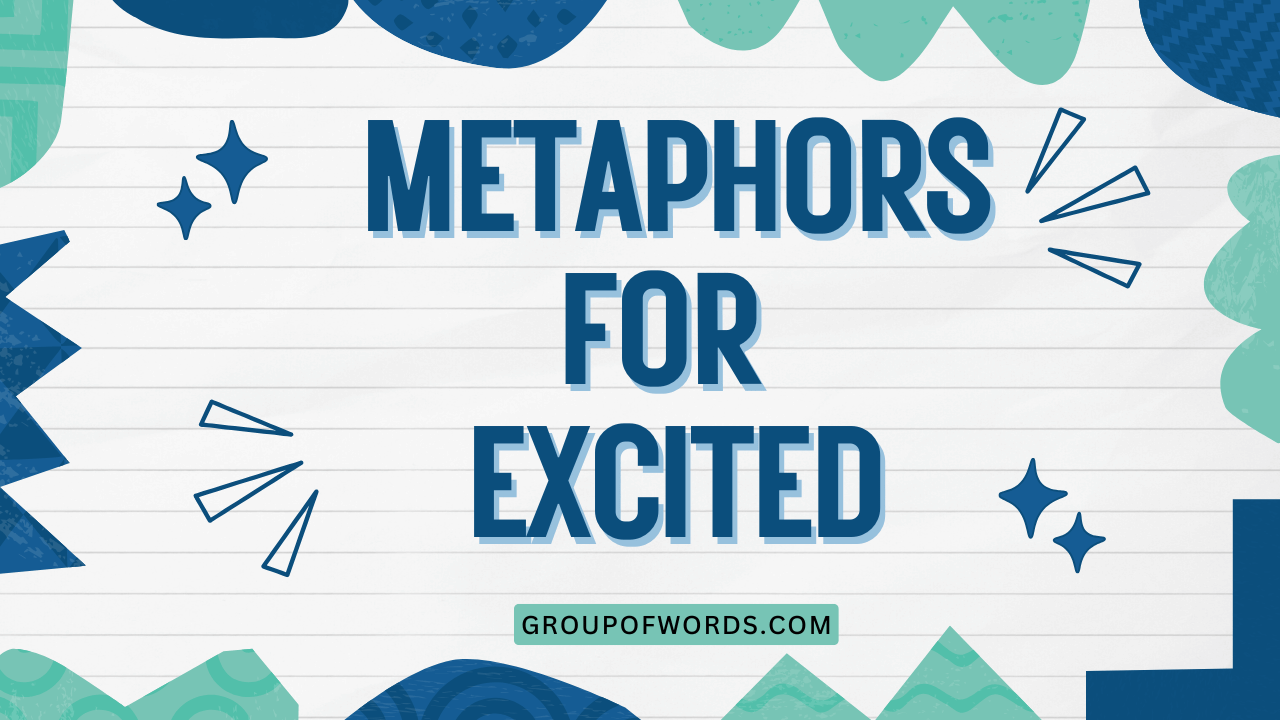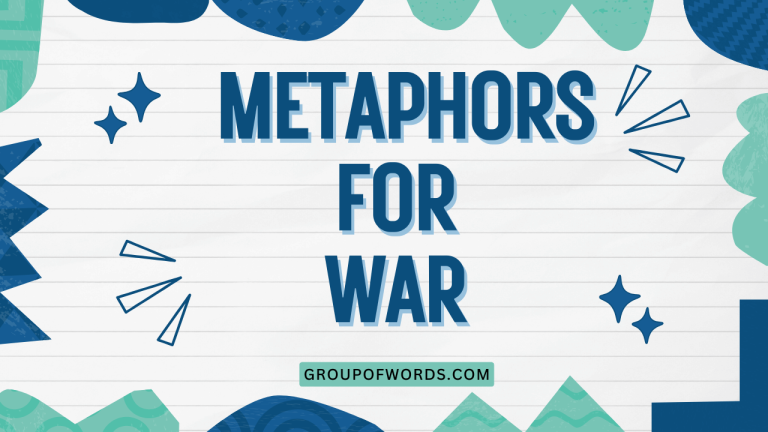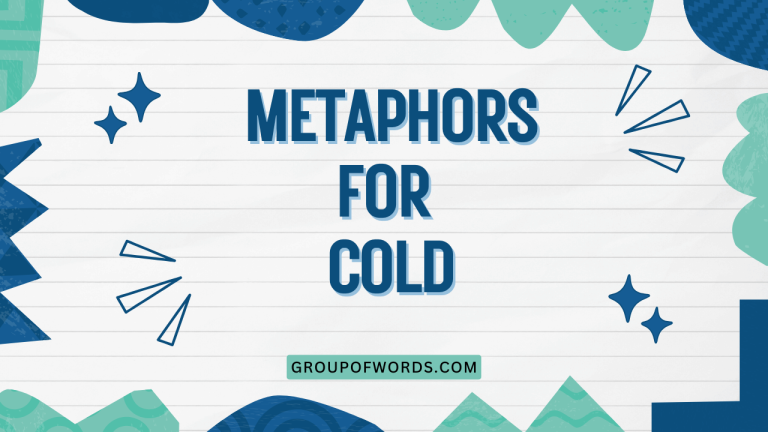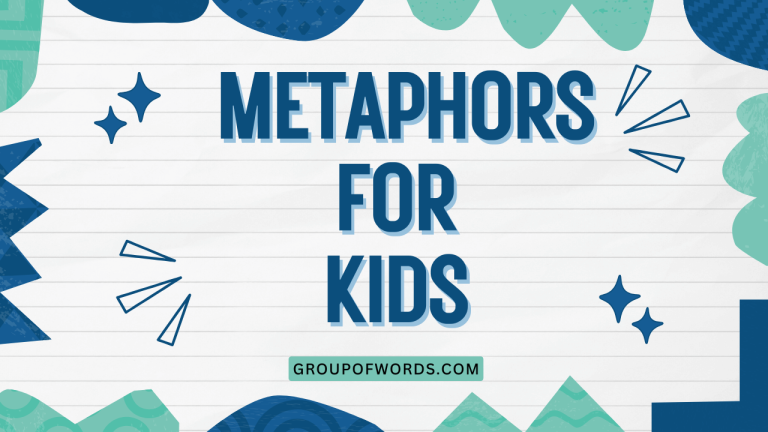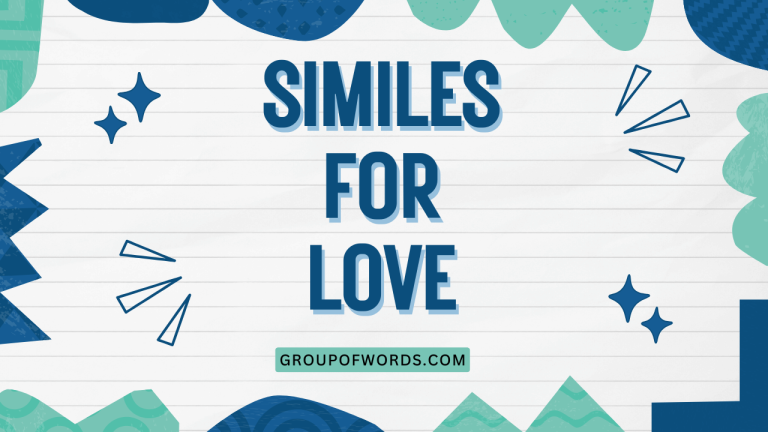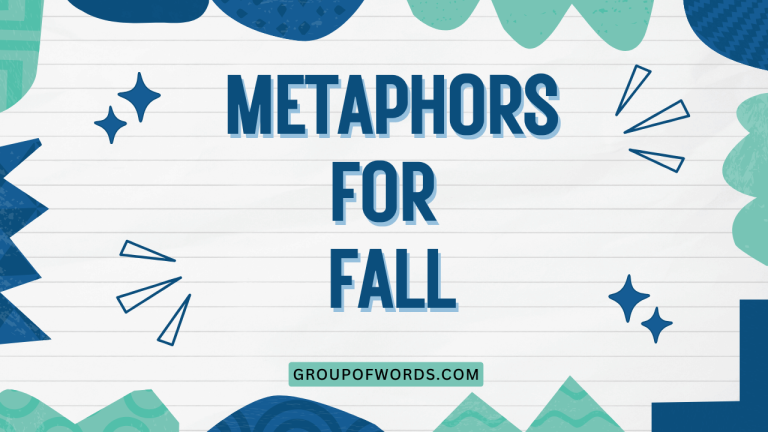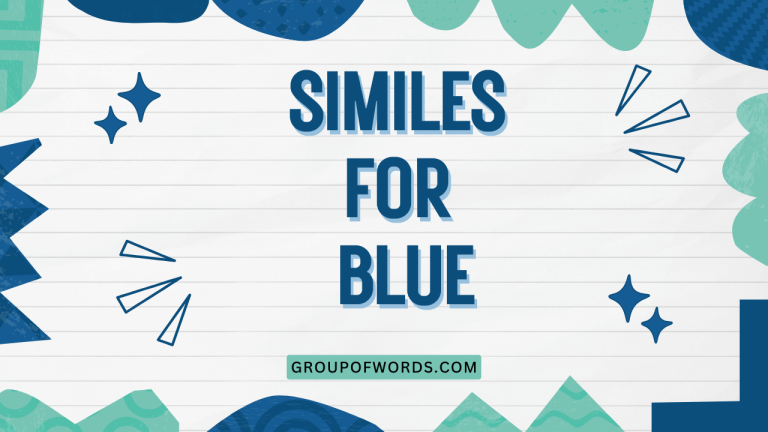Metaphors for Excited: A Comprehensive Guide
Understanding how to use metaphors to describe excitement is crucial for vivid and engaging communication. Metaphors allow us to express abstract emotions like excitement in relatable and imaginative ways, making our language more colorful and impactful.
This article provides an in-depth exploration of metaphors for “excited,” covering their definitions, structural breakdowns, types, usage rules, common mistakes, and practice exercises. This guide is perfect for English language learners, writers, and anyone looking to enhance their descriptive vocabulary.
Table of Contents
- Introduction
- Definition of Metaphor for Excited
- Structural Breakdown
- Types and Categories
- Examples
- Usage Rules
- Common Mistakes
- Practice Exercises
- Advanced Topics
- FAQ
- Conclusion
Introduction
Excitement is a powerful emotion that can be expressed in countless ways. While simple adjectives like “happy” or “thrilled” are useful, metaphors offer a more nuanced and evocative approach.
By using metaphors, we can paint a vivid picture of the feeling, making our writing and speech more engaging and memorable. This article will delve into the world of metaphors for “excited,” providing a comprehensive guide to understanding and using them effectively.
This guide is designed for language learners of all levels, from beginners seeking to expand their vocabulary to advanced speakers aiming to refine their descriptive skills. We’ll explore various types of metaphors, examine their structural components, and provide practical examples to illustrate their usage.
By the end of this article, you’ll be equipped with the knowledge and tools to use metaphors for “excited” with confidence and creativity.
Mastering the use of metaphors can transform your communication, adding depth and color to your expressions. This article will not only teach you about specific metaphors but also help you develop a deeper understanding of how metaphors work in general, allowing you to create your own unique and expressive language.
Definition of Metaphor for Excited
A metaphor is a figure of speech that directly compares two unrelated things, suggesting a similarity between them without using words like “like” or “as” (which would make it a simile). In the context of describing excitement, a metaphor uses a concrete image or concept to represent the abstract feeling of excitement.
Classification: Metaphors fall under the broader category of figurative language, which also includes similes, personification, and hyperbole. They are used to create vivid imagery and convey meaning beyond the literal sense of the words.
Function: The function of a metaphor for “excited” is to evoke a stronger emotional response in the reader or listener than a simple adjective could. It allows for a more imaginative and relatable understanding of the feeling.
Contexts: Metaphors for “excited” can be used in various contexts, including literature, poetry, everyday conversation, and professional writing. The specific metaphor chosen will depend on the desired tone and the audience.
Structural Breakdown
A metaphor typically consists of two main components: the tenor and the vehicle. The tenor is the subject being described (in this case, the feeling of excitement), and the vehicle is the object or concept used to represent it.
For example, in the metaphor “He was a volcano of excitement,” the tenor is “his excitement,” and the vehicle is “a volcano.” The metaphor suggests that his excitement was powerful, explosive, and potentially overwhelming, similar to a volcanic eruption.
The effectiveness of a metaphor depends on the relationship between the tenor and the vehicle. A good metaphor will create a clear and compelling connection between the two, allowing the reader or listener to easily understand the intended meaning.
The underlying principle is implicit comparison. Unlike similes that explicitly use “like” or “as”, metaphors imply the comparison, making the statement more forceful and direct. This direct comparison encourages the audience to make a mental leap, enriching their understanding.
Types and Categories
Metaphors for “excited” can be categorized in several ways, based on the type of imagery they evoke. Here are some common categories:
Physical Sensation Metaphors
These metaphors relate excitement to physical sensations like tingling, buzzing, or shaking. These often convey a sense of energy and anticipation.
Movement Metaphors
Movement metaphors use verbs of motion to describe excitement, such as “leaping,” “soaring,” or “bubbling.” These highlight the dynamic and energetic nature of the feeling.
Light and Brightness Metaphors
These metaphors associate excitement with light, brightness, and radiance, such as “glowing,” “sparkling,” or “illuminated.” They emphasize the positive and uplifting aspects of the emotion.
Animalistic Metaphors
These metaphors draw comparisons to animals known for their energy and enthusiasm, such as “a puppy,” “a hummingbird,” or “a racehorse.” They can add a playful or intense dimension to the description.
Natural Phenomenon Metaphors
These metaphors use natural phenomena like storms, volcanoes, or earthquakes to convey the intensity and power of excitement. These are often used to describe overwhelming or uncontrollable excitement.
Examples
Below are tables containing a multitude of examples of metaphors for “excited,” organized by category. Each example is designed to illustrate the diverse ways in which excitement can be expressed metaphorically.
Table 1: Physical Sensation Metaphors for Excited
This table displays metaphors that relate to physical sensations, offering a tangible way to understand the feeling of excitement.
| Metaphor | Explanation |
|---|---|
| She was buzzing with excitement. | Her excitement felt like a physical vibration or energy. |
| He had ants in his pants. | He was restless and unable to sit still due to excitement. |
| Her skin tingled with anticipation. | She felt a slight, prickly sensation due to her excitement. |
| He was wired with anticipation. | He felt energized and on edge with excitement. |
| Her heart fluttered like a hummingbird’s wings. | Her heart beat rapidly and erratically due to excitement. |
| He felt a surge of adrenaline. | He experienced a sudden rush of energy and excitement. |
| She was trembling with anticipation. | Her body shook slightly due to her excitement. |
| He was on pins and needles. | He felt anxious and restless with anticipation. |
| She felt electric with anticipation. | She felt energized and vibrant with excitement. |
| He was bursting at the seams. | He was so full of excitement that he could barely contain it. |
| She was vibrating with eagerness. | Her excitement felt like a subtle, internal tremor. |
| He felt his pulse quicken. | His heart rate increased due to excitement. |
| She was charged with enthusiasm. | She felt full of energy and eagerness. |
| He felt a tickle of anticipation in his stomach. | He experienced a slight, nervous feeling due to excitement. |
| She was on the edge of her seat. | She was very eager and attentive, barely able to contain her excitement. |
| He felt his blood racing. | His blood circulated faster due to excitement. |
| She was filled with a warm glow of anticipation. | She felt a comforting and pleasant sensation of excitement. |
| He was jittery with excitement. | He felt nervous and restless due to excitement. |
| She felt a shiver of delight. | She experienced a sudden, pleasurable sensation of excitement. |
| He was tingling with excitement from head to toe. | He felt a pervasive prickly sensation throughout his body due to excitement. |
| She felt bubbly inside. | She felt light and effervescent with excitement. |
| He was thrumming with eagerness. | He felt a steady, vibrant excitement. |
| She felt a rush of joy. | She experienced a sudden, overwhelming feeling of happiness and excitement. |
| He was jumping out of his skin. | He was extremely excited and restless. |
| She felt the energy coursing through her veins. | She felt a powerful surge of excitement and energy. |
Table 2: Movement Metaphors for Excited
This table showcases metaphors using verbs of motion to illustrate the dynamic nature of excitement.
| Metaphor | Explanation |
|---|---|
| He was leaping with joy. | He was jumping or moving energetically due to his happiness. |
| Her spirits soared. | Her mood lifted dramatically due to her excitement. |
| He was bubbling with enthusiasm. | He was overflowing with energy and excitement, like a bubbling liquid. |
| Her heart skipped a beat. | Her heart momentarily paused due to excitement or surprise. |
| He was bouncing off the walls. | He was extremely energetic and restless due to excitement. |
| Her anticipation was swelling. | Her excitement was growing and intensifying. |
| He was swept away by the news. | He was overwhelmed by the exciting news. |
| Her excitement overflowed. | Her excitement was so great that she couldn’t contain it. |
| He was carried away by the moment. | He was so caught up in the excitement that he lost himself in it. |
| Her hopes took flight. | Her hopes rose and became more optimistic due to her excitement. |
| He was propelled forward by his enthusiasm. | He was driven and motivated by his excitement. |
| Her imagination raced ahead. | Her thoughts moved quickly and eagerly due to her excitement. |
| He was propelled by anticipation. | He was driven forward by his excitement and eagerness. |
| Her joy cascaded over her. | Her joy poured over her like a waterfall due to her excitement. |
| He was swept up in the thrill. | He was completely immersed in the excitement. |
| Her spirits took flight. | Her mood lifted and became more optimistic due to her excitement. |
| He was driven by the promise of adventure. | He was motivated by the exciting prospect of adventure. |
| Her dreams danced in her head. | Her dreams moved vividly and playfully in her thoughts due to her excitement. |
| He was carried on a wave of excitement. | He was supported and propelled by a surge of excitement. |
| Her excitement bubbled to the surface. | Her excitement became visible and apparent. |
| He was racing toward the finish line. | He was moving quickly and determinedly toward his goal due to his excitement. |
| Her heart danced with joy. | Her heart felt light and joyful due to her excitement. |
| He was floating on cloud nine. | He felt extremely happy and euphoric due to his excitement. |
| Her thoughts were spiraling with anticipation. | Her thoughts were moving in a complex and eager pattern due to her excitement. |
| He was walking on air. | He felt extremely happy and elated due to his excitement. |
Table 3: Light and Brightness Metaphors for Excited
This table presents metaphors associating excitement with light, brightness, and radiance, highlighting the positive aspects of the emotion.
| Metaphor | Explanation |
|---|---|
| She was glowing with excitement. | Her excitement made her appear radiant and happy. |
| He was sparkling with anticipation. | His eyes shone brightly with excitement. |
| Her face lit up with joy. | Her expression became bright and cheerful due to her excitement. |
| He was illuminated by the news. | The exciting news made him feel enlightened and happy. |
| Her smile radiated happiness. | Her smile spread joy and positivity due to her excitement. |
| He was beaming with pride. | He was smiling broadly and showing great satisfaction due to his excitement. |
| Her eyes shone with delight. | Her eyes sparkled with happiness and excitement. |
| He was a beacon of enthusiasm. | He was a source of inspiration and excitement for others. |
| Her spirit shimmered with joy. | Her inner happiness was reflected in her radiant appearance. |
| He was ablaze with passion. | He was filled with intense enthusiasm and excitement. |
| Her excitement cast a golden glow. | Her excitement created a warm and positive atmosphere. |
| He was a ray of sunshine. | He brought happiness and positivity due to his excitement. |
| Her energy was incandescent. | Her energy was intensely bright and radiant due to her excitement. |
| He was a shining example of enthusiasm. | He was an outstanding role model for excitement and eagerness. |
| Her joy was dazzling. | Her joy was so bright and intense that it was almost overwhelming. |
| He was alight with anticipation. | He was filled with a bright and eager excitement. |
| Her laughter was like sunshine. | Her laughter was bright, warm, and cheerful due to her excitement. |
| He was a bright spark of energy. | He was a source of vitality and enthusiasm. |
| Her enthusiasm was radiant. | Her enthusiasm shone brightly and positively. |
| He was glowing with anticipation. | He appeared radiant and happy due to his excitement. |
| Her happiness illuminated the room. | Her happiness filled the room with a bright and positive atmosphere. |
| He was a luminous presence. | He exuded a bright and positive energy due to his excitement. |
| Her spirit was effervescent. | Her spirit was light, lively, and sparkling due to her excitement. |
| He was a firework of enthusiasm. | He displayed a brilliant and explosive display of excitement. |
| Her excitement was electrifying. | Her excitement created a thrilling and energetic atmosphere. |
Table 4: Animalistic Metaphors for Excited
This table explores metaphors that draw comparisons to animals known for their energy and enthusiasm, adding a playful or intense dimension to the description.
| Metaphor | Explanation |
|---|---|
| He was like a puppy with two tails. | He was extremely happy and energetic. |
| She was as eager as a hummingbird. | She was very enthusiastic and quick to act. |
| He was a racehorse at the starting gate. | He was eager and ready to go. |
| She was as excited as a kid in a candy store. | She was very thrilled and delighted. |
| He was like a dog chasing its tail. | He was full of restless energy and excitement. |
| She was chirping with excitement. | She was expressing her excitement in a lively and cheerful way. |
| He was as playful as a kitten. | He was full of energy and joy. |
| She was like a bee buzzing around a flower. | She was actively and eagerly pursuing her interests. |
| He was as giddy as a schoolgirl. | He was very excited and silly. |
| She was as jumpy as a kangaroo. | She was full of energy and anticipation. |
| He was as restless as a caged tiger. | He was full of pent-up energy and excitement. |
| She was as enthusiastic as a dolphin leaping from the water. | She was full of joy and excitement. |
| He was like a squirrel gathering nuts. | He was busily and eagerly preparing for something. |
| She was as lively as a cricket. | She was full of energy and enthusiasm. |
| He was as animated as a cartoon character. | He was full of exaggerated expressions and energy. |
| She was as cheerful as a songbird. | She was full of happy and uplifting energy. |
| He was as excited as a kid on Christmas morning. | He was extremely thrilled and delighted. |
| She was like a butterfly flitting from flower to flower. | She was moving lightly and joyfully. |
| He was as eager as a beaver building a dam. | He was diligently and enthusiastically working towards a goal. |
| She was like a bird taking its first flight. | She was experiencing a sense of freedom and excitement. |
| He was as happy as a clam at high tide. | He was completely content and joyful. |
| She was as playful as a otter sliding down a riverbank. | She was full of fun and energy. |
| He was as energetic as a monkey swinging through the trees. | He was full of boundless energy and enthusiasm. |
| She was like a gazelle leaping across the savanna. | She was moving gracefully and energetically. |
| He was as excited as a bear waking up from hibernation. | He was full of renewed energy and enthusiasm. |
Table 5: Natural Phenomenon Metaphors for Excited
This table contains metaphors using natural phenomena like storms, volcanoes, or earthquakes to convey the intensity and power of excitement.
| Metaphor | Explanation |
|---|---|
| He was a volcano of excitement. | His excitement was powerful and explosive. |
| Her anticipation was a rising tide. | Her excitement was building steadily. |
| He was a whirlwind of energy. | He was full of chaotic and intense energy. |
| Her joy was like a summer breeze. | Her happiness was gentle and refreshing. |
| He was struck by a lightning bolt of inspiration. | He had a sudden and powerful idea. |
| Her enthusiasm was a roaring fire. | Her excitement was intense and passionate. |
| He was a geyser of enthusiasm. | He was overflowing with excitement and energy. |
| Her excitement was like a sunrise. | Her happiness was radiant and uplifting. |
| He was a thunderstorm of emotion. | He was experiencing a powerful and overwhelming range of feelings. |
| Her spirit was like a waterfall. | Her energy was abundant and free-flowing. |
| He was a force of nature. | He was a powerful and unstoppable presence. |
| Her excitement was like a shooting star. | Her happiness was brief but brilliant. |
| He was an earthquake of emotion. | He was experiencing a sudden and intense emotional upheaval. |
| Her joy was like a rainbow after the rain. | Her happiness was beautiful and hopeful after a difficult time. |
| He was a tidal wave of enthusiasm. | He was experiencing an overwhelming surge of excitement. |
| Her anticipation was a gathering storm. | Her excitement was building up to a climax. |
| He was a supernova of excitement. | He was experiencing an incredibly bright and intense burst of happiness. |
| Her enthusiasm was like a forest fire. | Her excitement was spreading rapidly and uncontrollably. |
| He was a torrent of energy. | He was overflowing with intense and unstoppable energy. |
| Her excitement was like a spring thaw. | Her happiness was bringing new life and energy. |
| He was a blizzard of enthusiasm. | He was overwhelming everyone with his intense excitement. |
| Her joy was like a field of wildflowers. | Her happiness was vibrant and abundant. |
| He was a hurricane of emotion. | He was experiencing a powerful and destructive range of feelings. |
| Her spirit was like a mountain stream. | Her energy was pure, clear, and refreshing. |
| He was a solar flare of excitement. | He was experiencing a sudden and intense burst of happiness. |
Usage Rules
When using metaphors for “excited,” it’s important to consider the following rules:
- Clarity: The metaphor should be easily understood by the audience. Avoid overly obscure or complex comparisons.
- Relevance: The vehicle should have a clear connection to the tenor (the feeling of excitement). The comparison should be meaningful and appropriate.
- Consistency: Maintain a consistent tone and style throughout your writing. Avoid mixing metaphors that clash or create conflicting images.
- Originality: Strive for originality in your metaphors. While common metaphors can be effective, a fresh and creative comparison can be even more impactful.
- Context: Consider the context in which the metaphor is being used. The appropriateness of a metaphor can vary depending on the situation and the audience.
Avoiding Mixed Metaphors: A mixed metaphor combines two or more incompatible metaphors, often creating a confusing or humorous effect. For example, “He was burning the midnight oil at both ends” mixes the metaphor of “burning the midnight oil” (working late) with the idea of burning something at both ends (consuming it quickly). It’s crucial to maintain consistency in your imagery.
Overuse: While metaphors can enhance writing, overuse can make it seem forced or unnatural. Use metaphors judiciously to add emphasis and color, but don’t rely on them excessively.
Common Mistakes
Here are some common mistakes to avoid when using metaphors for “excited”:
| Incorrect | Correct | Explanation |
|---|---|---|
| He was excited like a roaring fire. | He was a roaring fire of excitement. | The first sentence uses “like,” making it a simile, not a metaphor. |
| She was a puppy, but not really. | She was a puppy of enthusiasm. | Metaphors should be direct comparisons, not qualified statements. |
| He was bubbling with excitement and also a stone. | He was bubbling with excitement. | Avoid mixing incompatible metaphors. The image of bubbling water and a stone is conflicting. |
| Her excitement was a car. | Her excitement was a speeding car. | The metaphor should create a meaningful comparison. “A car” is too vague. |
| He was very, very excited. He was like, super excited. | He was a volcano of excitement. | Avoid using metaphors as mere intensifiers. They should add depth and imagery. |
Practice Exercises
Test your understanding of metaphors for “excited” with these exercises. Choose the best metaphor to complete each sentence.
Exercise 1: Identifying Metaphors
Identify which of the following sentences contains a metaphor for “excited.”
| Question | Options | Answer |
|---|---|---|
| Which sentence contains a metaphor for excitement? | a) She was happy. b) She was like a jumping bean. c) She was a firework of joy. d) She felt excited. | c) She was a firework of joy. |
| Which sentence contains a metaphor for excitement? | a) He was thrilled. b) He was as excited as a puppy. c) He was a geyser of enthusiasm. d) He felt a surge of happiness. | c) He was a geyser of enthusiasm. |
| Which sentence contains a metaphor for excitement? | a) She was very excited. b) She was like a hummingbird. c) She was glowing with anticipation. d) She was jumping up and down. | c) She was glowing with anticipation. |
| Which sentence contains a metaphor for excitement? | a) He was happy and excited. b) He was a racehorse at the starting gate. c) He was thrilled beyond words. d) He felt excited. | b) He was a racehorse at the starting gate. |
| Which sentence contains a metaphor for excitement? | a) She was happy. b) She was like a child on christmas morning. c) She was a whirlwind of energy. d) She felt excited. | c) She was a whirlwind of energy. |
| Which sentence contains a metaphor for excitement? | a) He was thrilled. b) He was as excited as a puppy. c) He was an earthquake of emotion. d) He felt a surge of happiness. | c) He was an earthquake of emotion. |
| Which sentence contains a metaphor for excitement? | a) She was very excited. b) She was like a hummingbird. c) She was a beacon of enthusiasm. d) She was jumping up and down. | c) She was a beacon of enthusiasm. |
| Which sentence contains a metaphor for excitement? | a) He was happy and excited. b) He was a tidal wave of enthusiasm. c) He was thrilled beyond words. d) He felt excited. | b) He was a tidal wave of enthusiasm. |
| Which sentence contains a metaphor for excitement? | a) She was happy. b) She was like a child on christmas morning. c) She was a supernova of excitement. d) She felt excited. | c) She was a supernova of excitement. |
| Which sentence contains a metaphor for excitement? | a) He was thrilled. b) He was as excited as a puppy. c) He was a solar flare of excitement. d) He felt a surge of happiness. | c) He was a solar flare of excitement. |
Exercise 2: Completing Metaphors
Complete the following sentences with an appropriate metaphor for “excited.”
| Question | Answer |
|---|---|
| He was so excited; he was a ________. | He was so excited; he was a jumping bean. |
| Her anticipation was ________. | Her anticipation was a rising tide. |
| She was ________ with joy. | She was sparkling with joy. |
| He was a ________ of enthusiasm. | He was a whirlwind of enthusiasm. |
| Her excitement ________. | Her excitement overflowed. |
| He was so excited; he was a ________. | He was so excited; he was a firework. |
| Her anticipation was ________. | Her anticipation was electric. |
| She was ________ with joy. | She was glowing with joy. |
| He was a ________ of enthusiasm. | He was a dynamo of enthusiasm. |
| Her excitement ________. | Her excitement bubbled to the surface. |
Exercise 3: Creating Your Own Metaphors
Create your own metaphors for “excited” based on the given categories.
| Category | Your Metaphor |
|---|---|
| Physical Sensation | My body was thrumming with excitement. |
| Movement | His hopes took flight. |
| Light and Brightness | Her face lit up with joy. |
| Animalistic | He was as happy as a clam. |
| Natural Phenomenon | She was a tidal wave of enthusiasm. |
Advanced Topics
For advanced learners, consider these more complex aspects of metaphors:
Extended Metaphors: An extended metaphor is a metaphor that is developed over several lines or paragraphs. It allows for a more detailed and nuanced comparison.
Dead Metaphors: A dead metaphor is a metaphor that has become so common that it is no longer recognized as a figure of speech. For example, “the leg of a table” was once a metaphor, but it is now a literal term.
Mixed Metaphors and Intentional Use: While mixed metaphors are generally to be avoided, they can be used intentionally for humorous or satirical effect.
Cultural Context: The effectiveness of a metaphor can depend on the cultural background of the audience. Some metaphors may be more meaningful or relevant in certain cultures than others.
FAQ
Here are some frequently asked questions about metaphors for “excited”:
- What is the difference between a metaphor and a simile? A metaphor directly compares two things without using “like” or “as,” while a simile uses “like” or “as” to make the comparison explicit. For example, “He was a volcano” (metaphor) vs. “He was like a volcano” (simile).
- How can I come up with original metaphors? Observe the world around you and look for unexpected connections between different things. Think about the qualities of excitement and how they might be reflected in other objects or concepts.
- Is it okay to use common metaphors? Common metaphors can be effective, especially if you’re aiming for clarity and accessibility. However, striving for originality can make your writing more engaging and memorable.
- How many metaphors should I use in a piece of writing? Use metaphors judiciously. Too few, and your writing may lack color; too many, and it may seem forced or unnatural. Let the context and purpose of your writing guide your decision.
- What if my metaphor is not understood by the audience? Choose metaphors that are relevant and accessible to your target audience. If you’re unsure whether a metaphor will be understood, consider providing additional context or explanation.
- Can I use metaphors in formal writing? Yes, metaphors can be used in formal writing, but they should be used carefully and appropriately. Avoid overly informal or colloquial metaphors.
- How do I avoid mixed metaphors? Pay attention to the imagery you’re creating and ensure that the different metaphors you use are compatible with each other. If you find that your metaphors are clashing, revise them to create a more consistent and coherent image.
- Where can I find inspiration for metaphors? Read widely and pay attention to the language used by other writers. Look for metaphors in literature, poetry, and everyday conversation. You can also try brainstorming different ideas and exploring the connections between them.
Conclusion
Master
ing metaphors for “excited” is a valuable skill for enhancing your communication and creative expression. By understanding the structure, types, and usage rules of metaphors, you can effectively convey the intensity and nuances of excitement in your writing and speech.
Remember to practice regularly and explore different ways of expressing this powerful emotion. With dedication and creativity, you can transform your language and captivate your audience with vivid and imaginative descriptions.
